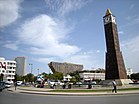User:Bigmoney/Sandbox3: Difference between revisions
| Line 30: | Line 30: | ||
| subdivision_type3 = Municipal Councils | | subdivision_type3 = Municipal Councils | ||
| subdivision_name3 = {{Collapsible list | | subdivision_name3 = {{Collapsible list | ||
| | |Civitas Universitatis | ||
| | |Hippo Diarrhytus | ||
| | |Malaka-Riverfront | ||
| | |Saint Augustus | ||
|Jewish Quarter | |Jewish Quarter | ||
| | |Tyria-Utica | ||
| | |Thapsus | ||
| | |Sexi Firmum | ||
| | |Tas-Silġ | ||
| | |Ugarit-Harbor | ||
| | | | ||
| | | | ||
Revision as of 23:04, 22 February 2022
New Tyria
New Tyria
| |
|---|---|
| The City of New Tyria | |
|
Clockwise from top: New Tyria cityscape, Hall of Workers' Councils, Šidduni Square, The Latin Ampitheatre, National University of Tyreseia Wechsler Library | |
| Nicknames: The Big Olive, NTC | |
| Country | |
| Metropolis | Tyria |
| Region | Greater Tyria |
| Municipal Councils | List
|
| Rebuilt | 180s BCE |
| Government | |
| • Type | Urban association |
| • Body | Tyria Multi-Municipal Council |
| Population (2020) | |
| • Total | 8,000,000 |
| Time zone | UTC+1 (Central Scipia Time) |
| Postal code | SH-001 to SH-999 |
| Area code | 11 to 19 |
New Tyria is the capital and largest city in the Workers' Federation of Tyreseia, with a population of 8,XXX,XXX as of the 2020 Census. It is located along the X Bay, the X River and the Periclean Sea.
Though the city lacks official legal status as the nation's capital city, New Tyria has nevertheless played an outsized role in Tyreseia's history, politics, and culture. Most of the nation's governmental institutions and unions are headquartered in the city, along with the world's embassies and diplomatic missions. Much of the administrative apparatus of the Rubric Coast Consortium is also based in New Tyria. The city also serves as a transportation and service hub, playing host to the nation's only international airport and its largest railway stations.
History
In the aftermath of a devastating earthquake in 191 BCE, the ancient and eponymous capital city of the Tyrian civilization, Tyria, was largely destroyed. At the time, the Latin Empire had recently concluded its intervention in the civil war between the merchant houses of Hiram and Eshmun. As the Latin-backed Hiramites had won, the legions present in the region were seeking a place to establish a new Hiramite client capital. The other major Tyrian city-states, including the Hiramite home base of Tsabratan, had suffered even greater destruction from war, pestilence, famine and the earthquake. As such, much to the Hiramites' chagrin, the capital site was selected a few kilometers east of old Tyria, along the X River. Much rubble from the old city was repurposed in building the new, with some ancient Tyrian monumental structures being cut down and rebuilt as they once were. Through the recycling of building material and whole buildings alike, the core of New Tyria was established in around 179 BCE, with the harbor and Temple of Jupiter (a reconstructed temple to Ba'al Hammon) as the focii of the design. The process of ignoring the Hiramites' choice of capital and desecrating Tyrian religious sites proved too much for many to bear, and many Hiramites rose up in revolt in 178 CE. The revolt, concentrated in the west and featuring some Eshmunites fighting alongside their former sworn enemy, was swiftly put down as numerous Latin forces had arrived to aid in New Tyria's construction and in securing their new client kingdom. In the aftermath, the region now known as Tyreseia was quickly transformed into a more directly-administrated province of the Empire, with the once-great Houses of Eshmun and Hiram being forcibly dissolved.
During the Latin period, the city saw a quick explosion in growth, seeing many peoples of both Tyrian and Latin descent migrating into the city. Other minority groups, including the city's first Jewish populations, ended up within New Tyria's walls as the combination of riverine transport, maritime trade and Latin financial support made the city grow rapidly in just a few centuries.
Geography
The site of New Tyria lays on strategic ground. The city lies along both the Periclean Sea coast and the X, a large delta branch of the Heshek River. This branch was artificially widened by successive Latin, medieval, and early-modern projects, making it easy to transport goods and people from the Periclean down the channel to the Heshek and vice versa.





